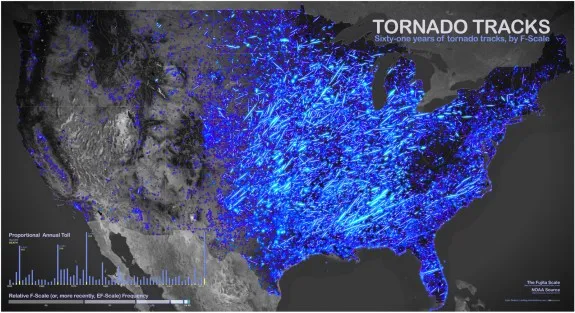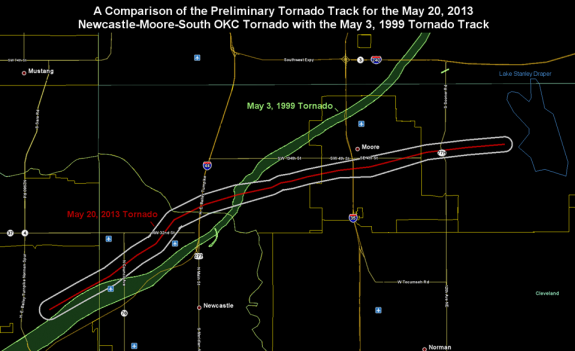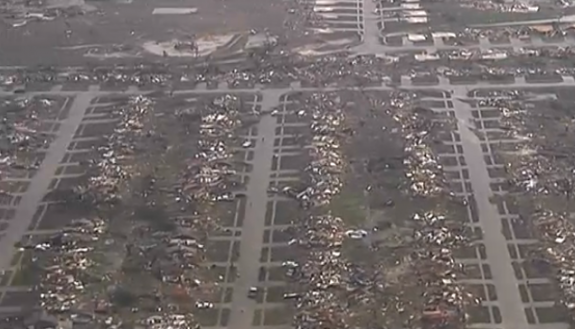How to Understand the Scale of the Oklahoma Tornado
In terms of size, speed and staying power the Oklahoma tornado was a force of nature
A timelapse video from wmctv shows the progress of the destructive Oklahoma tornado.
Update, 10:05 am, May 21, 2013: The Oklahoma City medical examiner said that at least 91 people had died as a result of the tornado but later revised that count, saying that only 24 deaths had been confirmed. Emergency workers were still working early this morning to make their way through debris at Plaza Towers Elementary School, where seven children have been found dead.
Originally posted on May 20: In Moore, Oklahoma, a suburb of Oklahoma City, an incredibly powerful tornado just came and went, a nearly hour-long ordeal that, as of the time of this writing, has trapped 75 school children in their school, injured hundreds of people and left a city in ruins.
A meteorologist for the local news station KFOR called the tornado “the worst tornado in the history of the world.” That assessment is quite apt.
There are a lot of parameters by which a tornado can be deemed the worst, and by pretty much all counts today’s Moore tornado is up there. The National Oceanographic and Atmospheric Administration keeps a list of historical tornadoes—devastating twisters known for their size, their duration and their destruction. Though the Moore tornado doesn’t trump any of them, its combination of size, strength and duration made it an incredibly dangerous storm.

One factor that really set today’s Moore tornado apart was its staggering size. According to The New York Times, today’s tornado was “perhaps a mile wide.” Other reports put it closer to two miles in width. According to NOAA, the largest tornado on record hit Hallam, Nebraska in 2004. That twister was two-and-a-half miles wide. “This is probably close to the maximum size for tornadoes; but it is possible that larger, unrecorded ones have occurred,” writes NOAA of the 2004 tornado.
On top of its massive girth, today’s tornado was also incredibly strong. The Associated Press reports that wind speeds in the twister hit upwards of 199 miles per hour (320 kilometers per hour). The record holder, says NOAA, saw winds peaking at 302 miles per hour (486 kilometers per hour.) That storm, unfortunately, hit pretty much the exact same place as this one. It swept just north of Moore on May 3, 1999.

But while the wind speed of today’s twister falls below that of the May 1999 storm, the damage caused by a tornado isn’t all due to wind speed. The amount of time that the storm stays on the ground is also incredibly important.
Today’s Moore tornado was on the ground for 40 minutes. Most tornadoes last just a few minutes. But they can sit around for up to an hour. One of the most deadly tornadoes in history, the 1925 Tri-State Tornado, sat on the ground for a terrifying three-and-a-half hours.

Of course, while all of these parameters are a window into the destructive potential of nature, what matters most to many is the toll on human life. Though casualties are at this point still uncertain, FOX’s KDVR reports that “more than 171,000 people were in the path of the storm.” Several casualties have already been reported, but it will take time for the full destructive power of the storm to become known.
Fortunately, at least, casualties will likely be below the record set by the the March 1925 tornado that swept through Missouri, Illinois and Indiana, the one that stayed down for 3.5 hours. That storm killed 695 people. Advances in early detection and warning systems have brought the deaths caused by tornadoes down over time, and one can only hope that people were able to seek shelter from the dark side of nature.
More from Smithsonian.com:
Surviving Tornado Alley
A Satellite View of Tornado Scars
This Might Be Why People Don’t Move Away From Tornado Zones
/https://tf-cmsv2-smithsonianmag-media.s3.amazonaws.com/accounts/headshot/smartnews-colin-schultz-240.jpg)


/https://tf-cmsv2-smithsonianmag-media.s3.amazonaws.com/accounts/headshot/smartnews-colin-schultz-240.jpg)